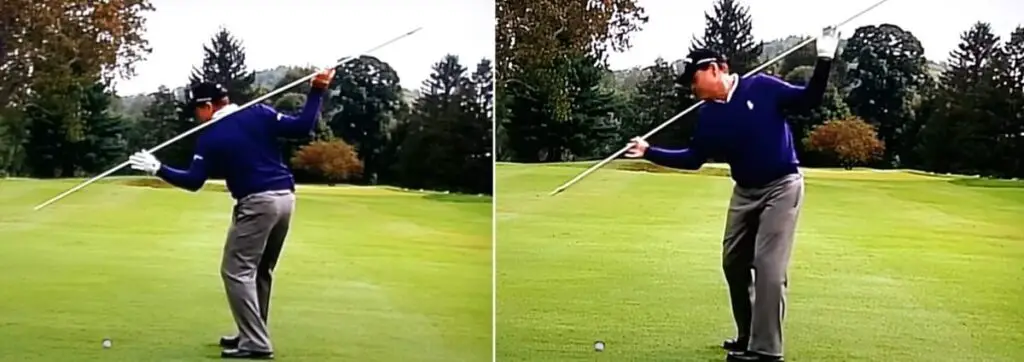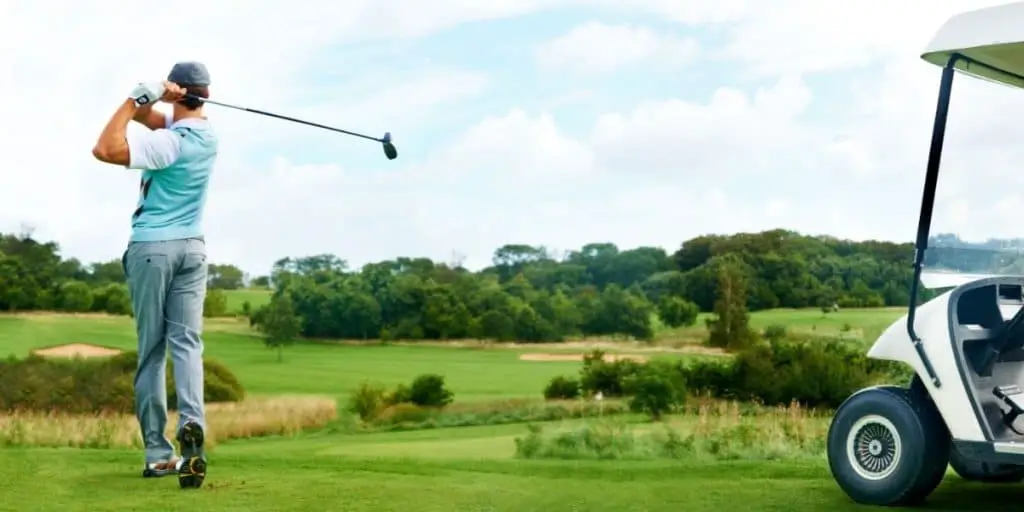Hitting a consistent slice with driver can be one of the most infuriating experiences in golf.
This issue can be even more frustrating when your iron game seems to be immune to this particular affliction. It’s almost like the golfing gods are punishing you for past discretions.
Fortunately, there are several avenues to explore, before you accept your fate as a slicer. In this post, we dive into why you slice your driver but not your irons.
Why You Slice Your Driver
Driver is the hardest club to turnover
If you watch the US Masters, you should notice that most professionals elect to hit 3 wood rather than driver on the 10th hole.
Professionals make this decision because the hole demands a draw, and it’s easier to hit a draw with a 3 wood than it is to hit a draw with a driver.
Even Rory Mcilroy, who has one of the most natural draw shapes in the game, talks about his own difficulties generating right to left spin with modern-day drivers.
There are a number of reasons that players struggle to turn their right hand over their left with driver specifically, including:
Large Driver Heads Can Be Difficult To Square At Impact
When it comes to driver specifically, the smaller the clubhead is, the easier it is to shape the ball. This is why companies like Titleist still offer 430 cc driver heads (rather than the industry standard of 460 cc).
The issue then, is that almost all modern driver heads are as large as they can legally be (460 cubic centimeters).
The larger club head increases the MOI, ultimately making modern drivers significantly more forgiving than their older counterparts. However, the extra-large clubhead size makes it more difficult to rotate the clubhead back to a square position at impact. If your clubface is open as you approach impact, there’s a strong possibility of hitting a slice.
Driver Shaft Length Makes It Difficult To Control
It is pretty obvious that driver is the longest club in a golfers bag (with the exception of people who play broomstick putters).
For men, a driver is usually in the region of 45 inches, whereas for women, it’s usually about 43 inches.
The longer a golf club is, the harder it is to control, in most cases. This is why so few professionals used a 48inch driver when that was still the legal limit (it has since been reduced to 46 inches).
For professionals, the extra inch or two compromised their accuracy stats so severely, that it made 48 inch drivers unplayable.
This principle applies to amateurs as well. It explains why shorter irons are easier to hit than longer irons, and it explains why a 4 iron is usually more accurate than a driver, for most players.
The underlying point is that the length of your driver will exacerbate any accuracy issues that are already present in your game. So, if you have a tendency to slice the golf ball, that tendency will be amplified when hitting the longest club in your bag.
You Swing Driver Faster Than Any Other Club
Another inescapable golf truism is that you swing your driver faster than any other club in your bag. This is because modern day drivers are so light, and the shaft is so long. When combined, this will produce your maximum clubhead speed.
The issue in this instance is once again linked to control. For most players, the faster the swing, the less control they have through impact. When fighting a slice, the extra swing speed will simply amplify the shape that you are trying to eliminate.
You hit Down on irons but hit Up with driver
There is a massive difference in angle of attack when comparing a well-struck drive to a well-struck iron shot.
With an iron in your hands, the goal is to hit down on the ball, trusting that the loft of the iron will send the ball into the air at the desired trajectory.
With a modern-day 460 cc driver, you will achieve maximum distance if you tee the ball up high and hit up on the ball. Simply put:
- Irons require a negative angle of attack
- Driver requires a positive angle of attack
The issue with this setup is that certain players may ‘swipe across the ball’, rather than hitting up on the ball when hitting their driver.
This is partly because so many players don’t really understand how to use their arms efficiently during the follow through. On this particular subject, you should look into the Arm Swing Illusion, discovered by Jim Waldron.
The basic premise is that golfers get sucked into the idea of moving their arms horizontally during the swing, when the predominant movement of the arms during the backswing and the followthrough is actually vertical.
In essence, you need to learn how to get the clubhead moving up and over your shoulder after impact, rather than swiping across the ball through impact.
You tee the ball up too far forward
This is quite an easy trap to fall into. While the ideal tee position is just inside your left heel, it’s easy to start teeing the ball up further and further in your stance.
When you tee the ball up too far ahead of you, it can introduce a number of unintentional compensations that you have to make in order to strike the ball well.
One of those compensations is leaving the clubface open at impact, in order to stop yourself from hooking the ball.
Thankfully, this is a relatively quick fix. You can lay one of your clubs inside your left heel on the practice range, or film yourself from a side-on position.
Once you get confirmation that you are in fact teeing the ball up too far forward, a single practice session is all you need to rectify your setup.
You have an issue with early extension during the follow through

Before you berate yourself for falling victim to this particular swing flaw, keep in mind that the great Tam Watson was also afflicted with an early extension problem for a large part of his career.
When you extend too early during the follow-through, the club automatically gets stuck behind you. In most cases, this makes it extremely difficult to return the clubface back to a square position at impact.
Instead, early extension traps the club behind you, encouraging the clubhead to move along an excessively in-to-out path. For most players, this results in a block or slice, unless you flip the club like a madman, which generally brings duck hooks into play.
Fortunately, you can address an early extension issue by focusing on maintaining your spine angle during the follow-through. Maintaining your spine angle is literally the key to Tom Watson’s secret.

Once you learn how to rotate around your spine, (rather than standing up and basically breaking your golf swing) you should find it much easier to strike your driver well, without worrying too much about that dreaded slice.
You don't know how to release the club efficiently
To a certain extent, you can actually get away with an inefficient release pattern when hitting irons. By having the ball further back in your stance, hitting down on the ball, and using your hand-eye coordination to generate a good strike, you can be a decent iron player in spite of your swing flaws.
However, driver tends to expose any existing swing flaws in a way that other clubs simply do not. Of these flaws, an inefficient release is generally the root cause of an uncontrollable slice.
In essence, your release is too late, and you don’t rotate the clubface back to a square position at impact. If this applies to you, working with a professional swing instructor is probably your best bet.
However, you could also try a swing aid like the Lag Shot Golf or the G Force Training Aid, before you commit to lessons. These training aids have ridiculously flexible shafts, and they can alter your understanding of how to release the clubhead through impact.
Once you start hitting straight shots with the LagShot, you should find it considerably easier to release your normal clubs with standard shafts.
Final Thoughts
In the end, it’s pretty clear that there are a number of reasons that can explain why you slice your driver but not your irons.
Thankfully, there are also a number of antidotes that you can try, and you only need one of them to work in order to cure that dreaded slice off the tee.


